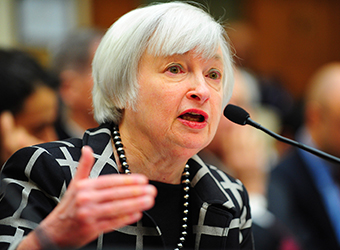The U.S. economy expanded at a modest to moderate pace in October through mid-November and inflation pressures increased, the Federal Reserve said on Wednesday in its periodic snapshot of the U.S. economy.
“Price pressures have strengthened since the last report,” the U.S. central bank said in its Beige Book survey based on anecdotal evidence provided by business contacts nationwide, an upgrade after several months of benign inflation assessments.
Many districts cited an increase in construction-material costs and several said there were rising costs in the transportation and manufacturing sectors.
Contacts also reported a slight improvement in their economic outlook as well as yet more evidence that the jobs market remains tight.
Tentative signs of an increase in pricing pressures may give heart to those Fed officials who have become increasingly anxious about weakening inflation.
The Fed’s preferred measure of inflation has been below its 2 percent target for more than five years, and has retreated for much of this year.
Despite still weak inflation overall, Fed policymakers are widely expected to raise interest rates in December for the third time this year against a backdrop of steady growth and low unemployment.
The economy grew at a 3.3 percent annual rate in the third quarter, its quickest pace in three years, the Commerce Department said earlier on Wednesday.
The majority of policymakers appear to have put more emphasis on the need to raise rates given the economy is at or near full employment rather than waiting until inflation appreciably rises.
On Tuesday, Fed governor Jerome Powell, who has been nominated by President Donald Trump to replace Janet Yellen as chief of the central bank, told a Senate confirmation hearing that conditions were supportive of a rate increase in December.
“The case for raising interest rates at our next meeting is coming together,” Powell, who will likely become chair in early 2018, told the Senate Banking Committee.
The unemployment rate fell to a near 17-year low of 4.1 percent in October although wages grew at their slowest annual pace in more than 1-1/2 years.
In the Fed’s report, tightness in the labor market was seen as widespread while wage growth was modest to moderate in most districts, with the largest wage increases going to employees in hard-to-fill jobs.
“Many districts reported that employers were raising wages as well as increasing their use of signing bonuses and other nonwage benefits to retain and attract employees,” the Fed said.


